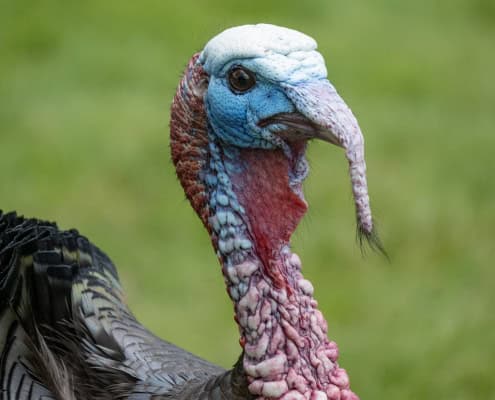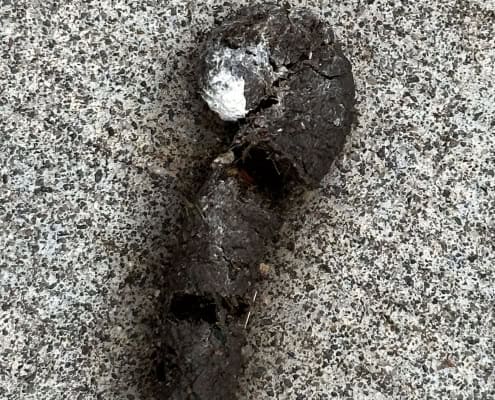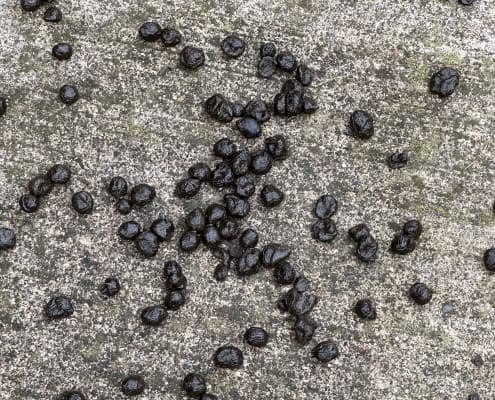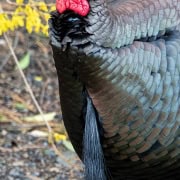Tom’s Beard and Other Information You Don’t Want to Know About Wild Turkeys
A Wild Turkey’s “beard” is the tuft that looks a bit like a miniature horsetail dangling from its breast. Year-old males (called “jakes”) have beards up to about five inches long, while toms three or more years old can have beards that are 10 inches or longer. Rarely, a tom will have one primary beard and one or two smaller beards just above it. About 5-10 percent of female turkeys may also sport short, thin beards. Many turkey hunters collect beards as trophies similar to deer and elk hunters collecting antlers — but the beards take up much less space.
The bristles in the cluster of stiff filaments are hair-like, but they are not hair. They are feather-like structures called mesofiloplumes. Their structural proteins are like feathers, but they lack a follicle and other characteristics of most feathers. Unlike feathers, turkey beards grow continuously.
The beard’s function is not known with certainty, but it might influence mate selection by hens. Longer beards signify older, healthier males and thus superior mates. Per Julie Craves, an ecologist and retired director of the Rouge River Bird Observatory in Dearborn, Michigan.
Spring jakes usually have 3- to 4-inch beards, though some early-hatched birds sport 5-inch beards. When a gobbler reaches 2, his beard is usually 8 to 10 inches. A beard gets its black color from melanin, a pigment that colors and strengthens feathers. The newly emerging beards of young turkeys contain little melanin, so the bristles are amber-colored. Even when a gobbler is 2, his beard will retain those original amber tips because they haven’t broken off yet. If you hold the beard of a 2-year-old gobbler under light, you’ll see the tips are mostly amber.
Some hens — maybe one in 20, depending on the location — also grow beards. Typically, hen beards are thin and measure 6 to 8 inches. From Brian Lovett’s Turkey & Turkey Hunting Blog

Full Beard
Color-Changing Head
Mood characterization is arguably more pronounced in wild turkeys than any other species of bird or mammal. With its head changing from red to white to blue, this distinct phenomenon is still not fully understood.
“Head color changes in males occur as birds become excited, agitated or otherwise change moods. We don’t fully understand what each color means, but there’s a fairly broad consensus amongst hunters that see birds often that red colors often signal irritation or fear. It is also believed that white on the top of the head serves as a form of signal, as that is often highly visible when males are excited and approaching hens” … From the National Wild Turkey Federation

Aren’t I grand?

Where are the bugs?
Who Pooped?
Yes, fresh turkey droppings can often be used to determine if the producer was male or female. Male turkey poop tends to be elongated or J-shaped, while the female’s is like a spiral blob, more or less similar to a snail’s shell. The contrasting configurations arise from the different internal anatomy of male and female turkeys. Many anatomical differences are common to all birds, but the males of some species, including turkeys, have a rudimentary internal sex organ. Since the structure is located close to the waste stream, it may influence the shape of droppings. Per Julie Craves

Tom’s Poop

Hen’s Pooop

Oh deer, is some sly hen trying to fool the peerless tracker?
The Fish and Game departments in several states that did not have turkeys were convinced to import some. Originally turkeys raised in game farms were released in the wild, but the birds did not survive since they hadn’t been taught how to find food. Eventually, success was achieved by trapping turkeys in Texas and Arizona for release in the new habitats. Texas turkeys were released in the Rogue Valley in 1975 and like typical Texans, soon multiplied and took over the territory.
A Texan turkey will flee as soon as it detects a human, but Oregon turkeys, when they are not shot at, will soon move into the “no hunting” areas or suburbs to share the suburban bounty that we all enjoy. (Extracts from Southern Oregon’s Bird Life by John Kemper)



Leave a Reply
Want to join the discussion?Feel free to contribute!